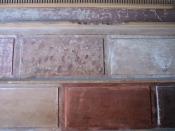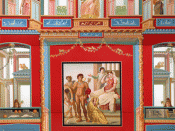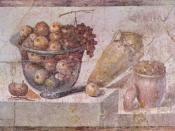Most paintings from the Roman era have been found in Pompeii and Herculaneum, and many other towns in the Bay of Naples. There are four different Pompeian styles of paintings. The division of the styles was based on fundamental differences in the way the artist would treat the wall and paint the space. The first two styles began during the Republican period and the third and fourth styles were found in imperial times.
The first Pompeian style began during the second century BC. During this time most of the house decorations were very simple, consisting of imitations of colored marble. A home owner who was not able to afford real marble would have commissioned a painted version. Plaster was used to emphasize the division of the painted blocks, and to also make the three-dimensional cornice with a horizontal border at the top. An example of this type of painting is the House of Sallust in Pompeii.
The second Pompeian style of wall painting began in Rome in the earlier years of the first century BC. This style of painting preserved a trace of the first style of painting; in that part of the walls were often painted with marbleized panels, while the whole scheme changed. The three-dimensional objects, like columns and ledges, were painted to look more realistic rather than being molded in plaster. The House of Griffins is an example of the second style. The House of Griffin was located on Palatine Hill. The walls flatness was emphasized by large central panels that were painted solid red. The other had marble patterns that gave the off the impression of being three-dimensional. The painters on the mid-first century BC treated the walls as if they were a sequence of windows leading to the outside world. Scenes with rocks, and birds...



Sources?
I like the topic- very interesting and eclectic here- but what's the point of telling us "A good example of the fourth style of painting can be found on page 96 of our textbook" when obviously we have no idea which books you use? At least edit your essay a bit before submitting them!
1 out of 2 people found this comment useful.